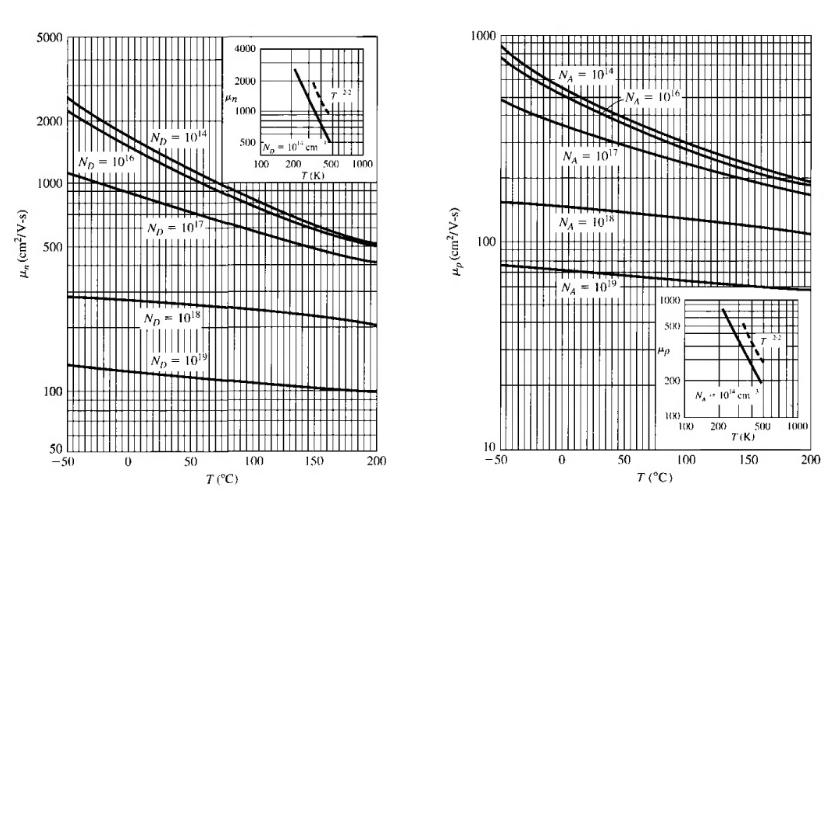为什么是PTAT电流源?
因为只有正负电压才相抵消啊?
不是带隙里
就是一般的偏置中
为什么用PTAT电流呢?
而不去做一个与温度无关的电流源。
My experience is: because circuit performances worsen when temperature goes up, and thus designers prefer higher bias current in high-temperature environment to maintain roughly the same performances such as open-loop gain, hysteresis...etc. Of course you can design a temp-independent current by summing a PTAT and an inverse-PTAT current sources.
proportinal to absolute temperature.
与温度成正比的电流,看razavi的bandgap一章。
Razavi书上讲得很清楚啊。
很多模块都需要一个PTAT电流去补偿另一个IPTAT电流,比如VGA里
一般情况下,不需要基准电流源吧,除非是对电流要求高的啊
这个说得有道理。
谢谢!
不过我觉得比较牵强
温度上升 电路的性能是变好还是变坏?
温度升高,迁移率增大,我觉得性能还会变好啊!~
运放里需要吗?
感觉补偿一下也不是特复杂,何乐而不为呢
Well, I sort of remember a rough principle in devices: when temperature goes up, everything is worse.
Actually mobility goes down when temperature goes up. It is not very hard to explain this because lattice scattering increases with temperature. Please refer to the attachment. It takes me a while to find this diagram.
Take a look at the approximation of gm, gm~M*Cox*(W/L)*(Vgs-VT), when temperature increases, M decreases, and the increase in bias current cause a increase in (Vgs-Vt) term, which compensates for the decrease of mobility. Of course it is a rough argument, but it does work for many designers.
As to your another argument, yes, it is not hard to achieve a nearly flat current output with respect to temperature by summing a PTAT and an I-PTAT curernt sources.
mobility vs temp.

OK thank you!
that is to say it is just the decreasing mobility leads to the poorer perfomance...?
Can the temperature coefficient of Vth compensate the decreasing mobility?
the diagram is from M.Sze's book....?
Partially right. I won't put an emphasis on Vt variation w.r.t. temperature since I would take care of (Vgs-Vt) term.
It is just an experience talk to use PTAT to bias your circuit. There definitely exists other applications that may require other type of current sources (temperature-independent or even I-PTAT) to obtain optimal performance. Right?
By the way, it is not from S.M. Sze's book, but I believe they are pretty much the same. Q_Q
怎么我记得温度上升,晶格散射加强,载流子平均自由程下降,迁移率下降?
迁移率先升高,后下降。常温时应该是下降的了,我记得是。现在手里没有书,查不到。
这个说得有道理。
温度上升,迁移率下降,op的gain减低,
ptat电流可以弥补迁移率下降的不足
It is kind of ambiguous to define the circuit performance is good or bad. More often, you want the circuit meets your specs while keeping power, die size, etc as small as possible. Therefore, depending on the target of your circuits, you sometimes want PTAT bias, but sometimes want others like constant-gm, bandgap.
BTW, high temp is not always "worse" than low temp, especially in deep sub-micron CMOS such as 45nm process. There is something called "inverse effect"
但是阈值电压也是负的温度系数,而且,对一些模块来说温度升高了大一点偏执并没有什么影响,没必要一定要做一个零温度系数的bias。
That's definitely what I try to express in my previous posts. A cercatin design would never claim superiority over other candidates at all time.
BTW, the remark "everything is worse when temp goes up" emerges from a device class that I took in Austin nearly 10 years ago. Maybe I cite this conclusion too imprudently. Thank you for the correction.
如果从gain的角度出发,gain正比于迁移率平方根,反比于电流平方根,PTAT电流应该使gain下降更多才对。
楼上正解
PTAT:正温度系数
Vbe:负温度系数
当然不是了,这样容易本征激发啊,温度升高的过程中迁移率还会下降呢
temperature sensor的就是用Iptat的来测试温度变化的,可能是这个。
How to creat inverse-PTAT current sources?
用带隙基准电路产生的PTAT电流作为内部电路的偏置,仿了一下不同corner下的情况,tt 110uA 、ss 107.7uA 、ff 87.8uA,这个变化是不是有点大啊。
还有,为什么tt时的PTAT电流最大,而不是ss的呢?
sensor 中用PTAT来监测温度很难精准,电阻corner无法控制 deltaVbe/R?
其实不是很明白PTAT电流源和与温度无关的电流源之间的关系,请知道者赐教!
